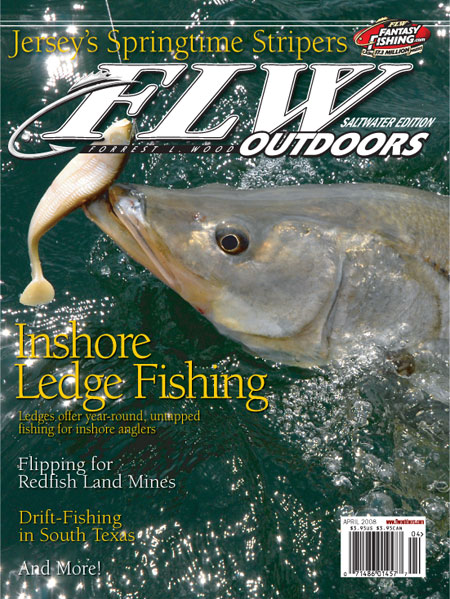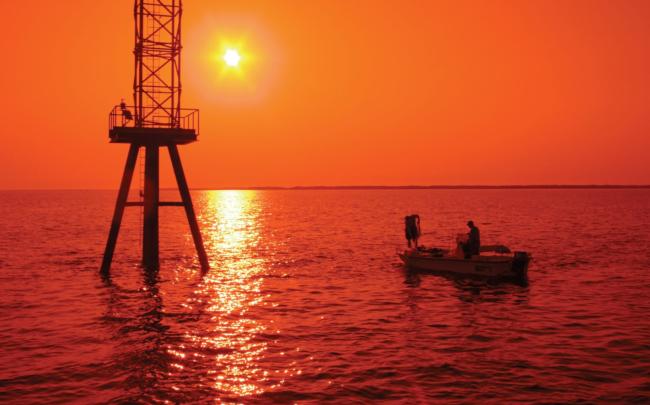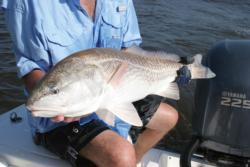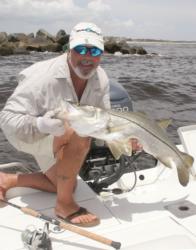Inshore ledge fishing
Ledges offer year-round untapped fishing for inshore anglers

The notion that ledges are fish havens is nothing new. In fact, offshore anglers targeting grouper, snapper, kingfish, and even billfish and tuna have successfully fished them for decades. Knowledgeable inshore fishermen have long scored on ledges as well. A patch-reef drop-off in a shallow sound may hold bait and Spanish mackerel, for example. A shell-bar ledge in the Intracoastal Waterway can produce everything from flounder and redfish, to striped bass and bluefish. But often there are small, overlooked, fish-filled ledges that many inshore anglers fail to notice.
“The entrances to backwater bays and small passes in mangrove or marsh shorelines can have very productive ledges many anglers overlook,” said angler Jake Markris of Fairhope, Ala., an avid local inshore-tournament angler. “Tide and current flowing through such necked-down areas cut ledges into the bottom, and they become feeding zones and migratory highways for all manner of game fish.
“Often a ledge in such a place of only a foot or so can be an important holding spot for fish. Such ledges at bay mouths or shoreline passes may cover 100 yards or more. The shallower the surrounding area of flats and bays, the more attractive a shallow ledge can be – especially for redfish, seatrout, flounder and other inshore species.”
Markris said such slight inshore ledges often are most productive when current is running strong across them, from the shallow side to the deeper side. Flounder, redfish, bonefish, striped bass, bluefish, permit, black drum, seatrout, ladyfish, snook, tarpon, sheepshead and other species often concentrate on the deep side of a ledge, watching and waiting for vulnerable baitfish, crabs, shrimp and other goodies to sweep over the drop.
“Some sand or mud ledges can have small key spots for productive fishing,” added Markris’ coastal-tournament fishing partner Kevin Olmstead, also from Alabama. “These ledge hot spots may be clusters of oysters or clams, rocks, boulders, weedbeds or pilings. Anything different along an inshore ledge can be a major fish magnet. Such things attract bait, and so are usually the best locations for game fish.”
 Olmstead and Markris have won a number of club and popular Alabama coastal fishing tournaments and rodeos targeting seatrout, redfish, flounder and tripletail. Many of those winning tournament fish have been caught from inshore ledges.
Olmstead and Markris have won a number of club and popular Alabama coastal fishing tournaments and rodeos targeting seatrout, redfish, flounder and tripletail. Many of those winning tournament fish have been caught from inshore ledges.
“Many good ledges are clearly evident on inshore charts and sometimes on aerial photographs,” Olmstead said. “Channel and range markers can lead the way to great ledge-fishing action, too. Inlet and river-mouth jetties, as well as standard riprap banks, can have superb ledge-fishing opportunities nearby.
“Bridges and causeways also create ledges. Concrete abutments alter tide and current flow, which build fish-attracting ledges. The mouths of feeder creeks in tidal rivers usually have small ledges that harbor fish, particularly during falling tides.”
Naturally, many of the best ledges are uncharted, unnoticed spots anglers cruise over daily on their way to other fishing locations. This is why it’s wise to keep a sharp eye on your fathometer whenever fishing inshore. A quick rise or drop in bottom can lead to a hot ledge loaded with fish. Some shallow ledges in clear, low-tide water under a sunny sky can be seen by observant anglers wearing good sunglasses and caps to shade the eyes.
Intracoastal Waterway ledges
The ICW is a ledge-fishing paradise. The man-made waterway has ledges of almost every description, and they offer good fishing from Maine to Texas. In many places, the ICW is a long, straight, dredged waterway that isn’t too appealing to fishermen. But fish usually don’t seem to mind, and they gravitate to ledges extremely well in such places, said Wal-Mart FLW Redfish Series pro, and popular inshore guide, Larry Miniard of Ponte Vedra, Fla. Miniard believes fishing such long, deep and undulating ledges while using a sensitive depth finder and an electric motor is a fast and productive way to locate prime spots and catch plenty of fish.
One of the most productive ICW redfish ledges is along a quarter-mile Florida oyster bank that’s as straight as an Arizona highway. With a tide running parallel to the ICW bank, I’ll use my skiff’s electric motor to make a controlled drift along the ledge, which runs 8 to 12 feet deep. Rarely do I fish the spot  without locating reds. And at times, the oyster bank drop-off offers great flounder, black drum and seatrout fishing as well.
without locating reds. And at times, the oyster bank drop-off offers great flounder, black drum and seatrout fishing as well.
Many ledges are man-made, particularly in the ICW and in lower tidewater rivers where shipping traffic is heavy. When the ICW was constructed, engineers utilized navigable inshore bays and rivers as much as possible, which made dredge work minimal. Yet even in natural bays and rivers where the ICW traverses, there commonly are ledges and pronounced drop-offs from dredging. These areas are prime feeding and holding places for all manner of game fish and generally receive light fishing pressure. Many such places are deep, with 15- to 40-foot drop-offs common, but difficult to locate and fish for many anglers, particularly in strong current or tide flow. Thus, they are overlooked, neglected inshore hot spots.
Fishing ledges in the ICW and other canal-like places often leads anglers to productive open-water, low-pressure fishing spots on big bays, sounds and open-river areas. Often where a dredged waterway crosses a river, for example, there will be deep, sunken points where two ledges converge – one from a river, another from a canal or dredged waterway. This produces submerged ledge points that can be remarkable fishing hot spots. Great fishing around deep ledge points is available according to tide phase, current strength, and time of year as it relates to migratory marine fish. Be aware, too, that one ledge point may be excellent during an incoming tide while a ledge point 100 yards away attracts fish during falling water.
For example, if the ICW is running north to south, and it crosses an east-to-west river, potentially there are four sunken “points” with adjoining ledges that may harbor inshore fish. Such spots may hold redfish in fall, seatrout in winter, flounder in spring and jacks in summer. It’s an angler’s task to learn what ledges and points hold what species in various tide and current flows, and at differing times of year. But the fish magnets are still the same year-round – ledges that form underwater highways and ambush feeding stations for predators.
This style of inshore structure fishing opens a lot of virgin water because almost no inshore anglers do it. Jim Romeka of Middleburg, Fla., who has competed in FLW Outdoors bass and redfish circuits, has bass-fishing skills that have greatly helped his inshore fishing. He said all it takes is a small boat with an electric motor, a sensitive depth finder, and enough time on the water to believe deep ledge fishing is productive.
Ledge logistics
Casting jigs, spoons and sinking plugs from boats perpendicular across ledges is most commonly practiced by anglers, but often a better way to fish them is to make parallel casts along or with ledges.
 Romeka believes this keeps lures in the most productive fishing water through the longest portion of a retrieve. By using a depth finder, keep the boat right on the drop-off, then cast ahead of the boat, so a lure lands on the drop and is fished right along it. Sometimes fish are shallower, up on top of a shelf (especially if it’s shell), so an occasional cast to shallower water should be made. But most of the time fish hold tight to the deep side of a ledge.
Romeka believes this keeps lures in the most productive fishing water through the longest portion of a retrieve. By using a depth finder, keep the boat right on the drop-off, then cast ahead of the boat, so a lure lands on the drop and is fished right along it. Sometimes fish are shallower, up on top of a shelf (especially if it’s shell), so an occasional cast to shallower water should be made. But most of the time fish hold tight to the deep side of a ledge.
Another good way to work ledges is with fish finders or Carolina rigs. A sliding egg sinker should be threaded onto the fishing line, and the line should be tied to a barrel swivel. Use a 3-foot leader (lighter in test than the fishing line) connected to a soft-plastic lure hook, like an Eagle Claw HP Hook. Natural baits can be used, but soft baits such as Berkley Gulp! and Mister Twister Exudes are deadly on most inshore fish.
Such a rig can be cast, but I have better luck slowly pulling it behind my boat with an electric motor on ledge drops while watching the fathometer for proper boat positioning. A baitcasting outfit with the reel set having the clicker on is great, and it can be placed in a rod holder at the boat stern while anglers cast jigs and other lures along and over ledges. Often the fish-finder rig is forgotten – until the reel clicker goes off, and frequently the biggest fish of the day is on. I’ve caught countless redfish this way, some over 20 pounds, and some surprisingly big flounder, jacks, striped bass, tarpon and snook. A few years ago I also hooked a stout cobia in Port Royal Sound, S.C. I guessed the fish at 40 pounds, but we lost it at boat side.
It sometimes makes sense to “snake-troll” while working ledges, particularly on unfamiliar water. Snake-trolling is maneuvering a boat back and forth across a ledge drop with an electric motor while casting and probing for fish. This works very well when pulling a fish-finder rig while cast jigs and plugs are used to “feel” or interpret undulating ledge areas.
Another good way to work broad ledges is to position a boat so it straddles a drop-off crosswise, bow on top of the ledge, stern on the deep side. A tide running parallel with the ledge helps hold a boat in position, with occasional nudges from an electric motor. With two or three anglers fishing, baits or lures are worked on a ledge deep side, as well as on the shallow shelf side. It’s an excellent way to thoroughly check a ledge, which produces all types of inshore fish.
 One spring day near Corpus Christi, Texas, friends and I caught more than two dozen black drum weighing up to about 6 pounds using this technique. Fish-finder rigs and fresh dead shrimp did the trick, and by controlled drifting across shell ledges with the boat, we were able to stay with moving schools of drum that sometimes were on top of the ledge, other times on the deep side. The same technique has produced sheepshead and even huge 1-pound croakers, which my kids love catching and I love eating.
One spring day near Corpus Christi, Texas, friends and I caught more than two dozen black drum weighing up to about 6 pounds using this technique. Fish-finder rigs and fresh dead shrimp did the trick, and by controlled drifting across shell ledges with the boat, we were able to stay with moving schools of drum that sometimes were on top of the ledge, other times on the deep side. The same technique has produced sheepshead and even huge 1-pound croakers, which my kids love catching and I love eating.
While many coastal areas have clear enough water to see color changes indicating drop-offs and ledges in 10 or 15 feet of water, that isn’t always the case. Tides can run hard and high; the water may be stained. This is why proper and careful use of a depth finder is so vital to consistent ledge-fishing success. Without a fathometer you have no idea exactly where ledges are located or how they turn along bottom, so you’re literally fishing blind and, therefore, not very well.
Often the broadest or widest flats that drop suddenly to deep water offer the best ledge fishing. Such places can be found near big feeder creek mouths or in areas where a canal makes a turn or two. Such spots may have fish-holding ledges or drops far off a bank, places that rarely see lures and baits, yet are easily found near channel markers. Tides and currents can be strong in such places, and fish often are deep. A heavy Hopkins Spoon cast upcurrent and allowed to tumble with the flow along bottom can be a killer for ledge fish in this situation.
Tide, naturally, makes a big difference on where, when and how fish feed and relate to a ledge. Only through experience can you learn one ledge holds fish in October during falling water, for example, while another similar spot is best in March during flood tide. That’s why this is run-and-gun fishing, meaning anglers are wise to stay on the move. Find a ledge, fish it carefully, but quickly. If no fish are found, fire the motor and locate another potential hot spot. There are hundreds of ledges, broad shell-bar drop-offs, underwater islands with well-defined edges, and similar structures throughout most tidewater regions. Many are in places you’ve probably run by a hundred times on your way to “better” fishing spots.
Remarkably, many of those ledges are untapped, and at various times of year, at certain tide stages, they’re loaded with feeding sport fish.